
Spacewalking astronauts finished repairs on a cosmic ray detector outside the International Space Station this weekend. The spacewalk officially started about 15 minutes late, at 7:04 a.m. EST (1204 GMT) Saturday and concluded at 1:20 p.m. EST (1720 GMT), with NASA astronaut Drew Morgan and European Space Agency astronaut Luca Parmitano spending 6 hours, 16 minutes working outside the station. The spacewalk was broadcast live on NASA Television.
The spacewalking pair was making repairs to the $2 billion Alpha Magnetic Spectrometer, a 9-year-old cosmic ray detector designed to seek out dark matter and antimatter. The instrument was launched in 2011 to seek out dark matter, dark energy, cosmic rays, and other cosmic phenomena so scientists can better understand the nature of the universe. It had studied more than 148 billion charged cosmic rays before it was shut down late last year for repair work. The project is led by Samuel Ting, a Nobel laureate at the Massachusetts Institute of Technology.
The instrument began experiencing issues in 2014. One of its four original carbon dioxide cooling pumps failed, and another one stared to degrade. Engineers switched over to the last fully functioning coolant pump in March 2017. Repair work began on the instrument in November.
Parmitano and Morgan were on the fourth of four spacewalks to fix AMS. Since it was not designed to be serviced in space, new tools had to be designed to repair the instrument. Now that AMS is ready for activation, scientists at the European Organization for Nuclear Research (CERN) will spend two days checking the device. Pending the success of these spacewalk repairs, AMS should now operate through the rest of the space station lifetime, which is currently projected for 2024.
Saturday’s spacewalk was the sixth for Parmitano and the seventh for Morgan. It was the third spacewalk in January 2020 for the Expedition 61 crew, which has performed nine spacewalks overall. It was the 227th spacewalk overall for the International Space Station.
